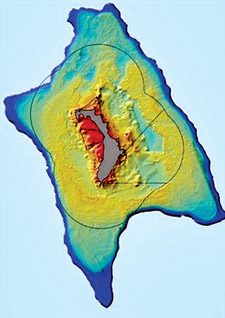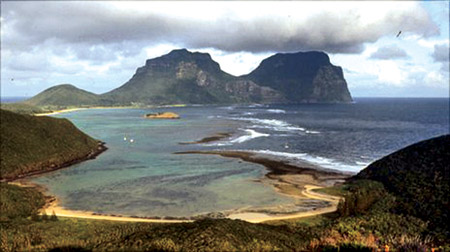|

Ancient coral reef
uncovered in South Pacific
An ancient reef found in the Pacific may provide clues to what will
happen to coral when sea temperatures rise.
A team of researchers from Australia and New Zealand have discovered
a huge 9,000-year-old reef surprisingly far south.
|

The modern reef appears in red, the ancient one in orange |
Lord Howe Island is 600km east of the Australian mainland and has a
small modern coral reef - the furthest south in the world. The ancient
reef however is nearly 30 times as large as the modern reef.
The scientists, headed by Colin Woodroffe from the University of
Wollongong in Australia and researchers from Geoscience Australia,
discovered a large ridge about 30m under water in the Tasman Sea. They
have published their work in Geophysical Research Letters. The team
suspected it might be an ancient reef. The size and shape of the ridge
can be mapped using a type of sonar called multi-beam echo sounding.
Theresearchers could not be sure it was coral until they had taken
samples. The modern reef appears in red, the ancient one in orange
Drilling for samples in the Tasman Sea is very dependent on weather
and the seas can be rough - it involves lowering a submersible drill
from a boat.The samples confirmed that it was indeed coral and
radiocarbon dating confirmed its age.
Other similar ancient reefs - called relict reefs - have been
discovered before, but none as far south as this. The team think that
this reef died when it was flooded as a result of sea levels rising
about 7,000 years ago, but the modern temperature at these latitudes
also limits coral growth, which is why the relict reef is so much bigger
than the modern reef.
|

The Tasman Sea relict reef |
Now that sea temperatures are rising, however, reefs may start to
grow bigger at higher latitudes. The relict reef doesn't have an
extensive modern reef attached to it but it does have some individual
corals which are newer - from the last 2,000 years.
This suggests that there is a suitable habitat for corals which might
grow into a larger reef when temperatures rise further. In the Northern
Hemisphere both Florida and Bermuda have small reefs, though they are at
the northern limits for coral life. It is possible that large relict
reefs might also be found in those northern waters. Like the Tasman Sea
relict reef, these might be able to support new growth.
In the Northern Hemisphere both Florida and Bermuda have small reefs,
though they are at the northern limits for coral life. It is possible
that large relict reefs might also be found in those northernwaters.
Like the Tasman Sea relict reef, these might be able to support new
growth.Rising sea temperatures are dangerous for coral reefs at hotter
tropical latitudes but they may mean we see new reef growth at the far
southern, and northern, limits of current reefs.
Courtesy: BBC Science News
|

